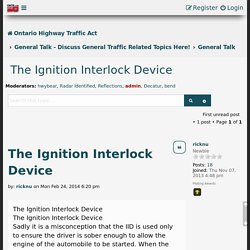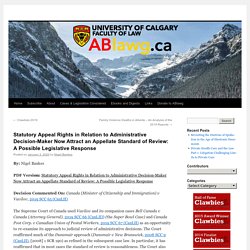

The Ignition Interlock Device - OHTA.ca. The Ignition Interlock Device Sadly it is a misconception that the IID is used only to ensure the driver is sober enough to allow the engine of the automobile to be started.

When the devices were first manufactured they actually were geared to this end. When it was discovered that upon occasion drivers who had been drinking got a friend to perform the test for them, the manufacturer built into the machine a process referred to as the Random Rolling Retest, At random intervals while the car is being driven, the driver will be asked by the machine to provide a breath sample.
Within a specified interval of time the breath sample must be provided. Should you be in a situation which requires your undivided attention while driving, the manufacturer claims, that if you fail to complete the test successfully, you will have enough time to either clear the scene or pull off the road to a stop.. So what repercussions may result from using this device in a rolling retest? September 2004 ... ex-eng.htm. What does justice for Breonna Taylor actually look like? B: The announcement was very, very moving.

At the same time, like a lot of people, I had a reaction that I'll sum up as "great, but": The size of the settlement is great, very definitely, but what about the officers who were involved in the flawed raid that took Taylor's life? Six months later, they still haven't been charged with a crime. "It's time to move forward with the criminal charges, because she deserves that and much more," is how Taylor's mom put it.
L: Yeah, that's true. It's also the largest settlement ever paid by the city of Louisville, right? B: I can sense a "but" coming ... L: You're not wrong! B: Which is why something else also jumped out at me: the promise to institute police reforms. All that's important, too, I think. L: Yes! B: That, to me, is the takeaway: The settlement is a big step, but it's still just one step on a longer path to justice. ICYMI: Patti LaBelle vs. Or as LaBelle put it, simply but no less movingly, "We are so happy to be together. "It's cool. Cop Fired After Stopping Black Shoppers For Being ‘Suspicious’ What is a statutory appeal. On what grounds can an employee appeal a disciplinary decision? There are no restrictions on the potential grounds on which an employee can appeal a disciplinary decision.

Paragraph 26 of the Acas code of practice on disciplinary and grievance procedures explains that an employee should appeal if they believe that a disciplinary decision is wrong or unjust. Consequently, employers must take a broad approach in allowing employees the right of appeal. Potential grounds of appeal could include that: new evidence has come to light that should be investigated;the sanction imposed was too severe or disproportionate to the misconduct;the sanction was inconsistent with one imposed for similar misconduct committed by another employee;there was unfairness or bias among the original decision-makers; orthe employer has not taken into account a previously exemplary disciplinary record. Statutory appeal – Irwin Law. Statutory Appeal Rights in Relation to Administrative Decision-Maker Now Attract an Appellate Standard of Review: A Possible Legislative Response. By: Nigel Bankes PDF Version: Statutory Appeal Rights in Relation to Administrative Decision-Maker Now Attract an Appellate Standard of Review: A Possible Legislative Response Decision Commented On: Canada (Minister of Citizenship and Immigration) v Vavilov, 2019 SCC 65 (CanLII) The Supreme Court of Canada used Vavilov and its companion cases Bell Canada v Canada (Attorney General), 2019 SCC 66 (CanLII)) (the Super Bowl Case) and Canada Post Corp. v Canadian Union of Postal Workers, 2019 SCC 67 (CanLII) as an opportunity to re-examine its approach to judicial review of administrative decisions.

The Court reaffirmed much of the Dunsmuir approach (Dunsmuir v New Brunswick, 2008 SCC 9 (CanLII), [2008] 1 SCR 190) as refined in the subsequent case law. In particular, it has reaffirmed that in most cases the standard of review is reasonableness. The majority recognized two manifestations of legislative intent that might rebut the presumption of reasonableness. Commentary.